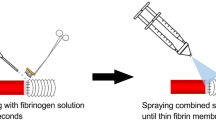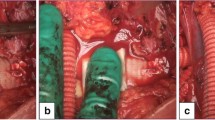Abstract
Objective: This study was performed to determine the most effective application method of fibrin glue as a hemostatic sealant in cardiovascular surgery. Methods: The effectiveness of fibrin glue as a hemostatic sealant was compared between 4 methods of application; dripping, spray, spray-and-rub, and rub-and-spray methods. I. In vitro ‘burst pressure’ was measured in fibrin glue-sealed needle holes of polytetrafluoroethylene (PTFE) graft in each method. II. Fibrin glue-sealed needle holes of PTFE grafts implanted between an abdominal aorta and iliac arteries of a pig was microscopically examined to determine the effectiveness of fibrin glue sealing in each method. Results: I. Burst pressures were 24.1±7.9 minHg in dripping, 98.1±35.4 mmHg in spray, 140.8±34.8 mmHg in spray-and-rub and 206.7±26.1 mmHg in rub-and-spray method (statistically significant, p<0.01, between each method). II. Microscopically, no fibrin glue remained on the external surface of the PTFE graft in the dripping method. Fibrin glue plugged 1/3 or 2/3 of the depth of the needle hole in the spray method and spray-and-rub methods respectively. In the rub-and-spray method, fibrin glue covered the needle hole over the external surface of the graft, completely plugged the needle hole to its whole depth, leaving no spaces where blood came into the needle hole. Conclusion: The rub-and-spray method of fibrin glue application revealed the strongest sealing and hemostatic effects, and can be safely and effectively used for hemostasis in cardiovascular surgery that requires systemic heparinization or prolonged extracorporeal circulation.
Similar content being viewed by others
References
Spangler HP, Braun F, Holle J, Moritz E, Wolner E. The local application of fibrinogen and collagen for hemostasis in heart surgery (in German). Wien Med Wochenschr 1976; 126: 86–9.
Walterbusch G, Haverich A, Borst HG. Clinical experience with fibrin glue for local bleeding control and sealing of vascular prostheses. Thorac Cardiovasc Surg 1982; 30: 234–5.
Spotnitz WD, Dalton MS, Baker JW, Nolan SP. Reduction of perioperative hemorrhage by anterior mediastinal spray application of fibrin glue during cardiac operations. Ann Thorac Surg 1987; 44: 529–31.
Redl H, Schlag G, Dinges HP. Methods of fibrin seal application. Thorac Cardiovasc Surg 1982; 30: 223–7.
Baker JW, Spotnitz WD, Nolan SP. A technique for spray application of fibrin glue during cardiac operations. Ann Thorac Surg 1987; 43: 564–5.
Fukunaga N, Uchida T, Kaetsu H, Kawakami K, Ishihara Y, Funatsu A. Effective application of fibrin sealant using a spray device with a double-tube structure. International J Adhesion Adhesives 1998; 18: 345–9.
Sawamura Y, Asaoka K, Terasaka S, Tada M, Uchida T. Evaluation of application techniques of fibrin sealant to prevent cerebrospinal fluid leakage: A new device for the application of aerosolized fibrin glue. Neurosurgery 1999; 44: 332–7.
Barbalinardo RJ, Citrin P, Franco CD, Hobson RW II. A comparison of isobutyl 2-cyanoacrylate glue, fibrin adhesive, and oxidized regenerated cellulose for control of needle hole bleeding from polytetrafluoroethylene vascular prostheses. J Vase Surg 1986; 4: 220–3.
Kram HB, Nugent P, Reuben BI, Shoemaker WC. Fibrin glue sealing of polytetrafluoroethylene vascular graft anastomoses: Comparison with oxidized cellulose. J Vase Surg 1988; 8: 563–8.
Jackson MR, Gillespie DL, Longenecker EG, Goff JM, Fiala LA, O’Donnell SD, et al. Hemostatic efficacy of fibrin sealant (human) on expanded poly-tetrafluoroethylene carotid patch angioplasty: A randomized clinical trial. J Vase Surg 1999; 30: 461–6.
Hill A, Estridge TD, Maroney M, Monnet E, Egbert B, Cruise G, et al. Treatment of suture line bleeding with a novel synthetic surgical sealant in a canine iliac PTFE graft model. J Biomed Mater Res 2001; 58: 308–12.
Schenk WG III, Goldthwaite CA Jr, Burks S, Spotnitz WD. Fibrin sealant facilitates hemostasis in arteriovenous polytetrafluoroethylene grafts for renal dialysis access. Am Surg 2002; 68: 728–32.
Nakajima S, Fukuda T, Hasue M, Sengoku Y, Haraoka J, Uchida T. New technique for application of fibrin sealant: Rubbing method devised to prevent cerebrospinal fluid leakage from dura mater sites repaired with expanded polytetrafluoroethylene surgical membranes. Neurosurgery 2001; 49: 117–23.
Gayle RG, Wheeler JR, Gregory RT, Snyder SO Jr. Evaluation of the expanded polytetrafluoroethylene (EPTFE) suture in peripheral vascular surgery using EPTFE prosthetic vascular grafts. J Cardiovasc Surg (Torino) 1988; 29: 556–9.
Dascombe WH, Dumanian G, Hong C, Heil BV, Labadie K, Hessel B, et al. Application of thrombin based fibrin glue and non-thrombin based batroxobin glue on intact human blood vessels: Evidence for transmural thrombin activity. Thromb Haemost 1997; 78:947–51.
Zarge JI, Gosselin C, Huang P, Greisler HP. Platelet deposition on ePTFE grafts coated with fibrin glue with or without FGF-1 and heparin. J Surg Res 1997; 67: 4–8.
Zarge JI, Husak V, Huang P, Greisler HP. Fibrin glue containing fibroblast growth factor type 1 and heparin decreases platelet deposition. Am J Surg 1997; 174: 188–92.
Kipshidze N, Ferguson JJ III, Keelan MH Jr, Sahota H, Komorowski R, Shankar LR, et al. Endoluminal reconstruction of the arterial wall with endothelial cell/glue matrix reduces restenosis in an atherosclerotic rabbit. J Am Coll Cardiol 2000; 36: 1396–403.
Byer A, Peters S, Settepani F, Pagliaro M, Galletti G. Fibrin sealant coated stents compared with non-coated stents in a porcine carotid artery model. Preliminary study report. J Cardiovasc Surg (Torino) 2001; 42: 543–9.
Author information
Authors and Affiliations
Rights and permissions
About this article
Cite this article
Minato, N., Shimokawa, T., Katayama, Y. et al. New application method of fibrin glue for more effective hemostasis in cardiovascular surgery. Jpn J Thorac Caridovasc Surg 52, 361–366 (2004). https://doi.org/10.1007/s11748-004-0011-5
Received:
Accepted:
Issue Date:
DOI: https://doi.org/10.1007/s11748-004-0011-5




